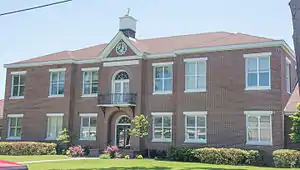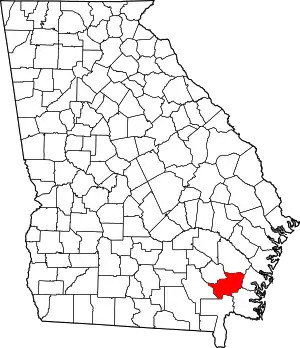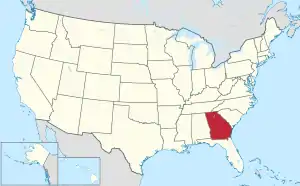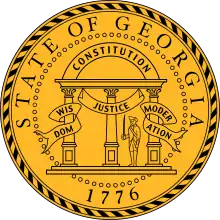Brantley County, Georgia
Brantley County is a county located in the southeastern part of the U.S. state of Georgia. As of the 2010 census, the population was 18,411.[1] The county seat is Nahunta.[2] Brantley County is part of the Brunswick, Georgia Metropolitan Statistical Area.
Brantley County | |
|---|---|
County | |
 Brantley County Courthouse in Nahunta | |
 Location within the U.S. state of Georgia | |
 Georgia's location within the U.S. | |
| Coordinates: 31°12′N 81°59′W | |
| Country | |
| State | |
| Founded | 1920 |
| Named for | Benjamin D. Brantley |
| Seat | Nahunta |
| Largest city | Nahunta |
| Area | |
| • Total | 447 sq mi (1,160 km2) |
| • Land | 442 sq mi (1,140 km2) |
| • Water | 4.8 sq mi (12 km2) 1.1%% |
| Population | |
| • Estimate (2019) | 19,109 |
| • Density | 42/sq mi (16/km2) |
| Time zone | UTC−5 (Eastern) |
| • Summer (DST) | UTC−4 (EDT) |
| Congressional district | 1st |
| Website | https://brantleycountyga.com/ |
History
Georgia voters passed a state constitutional amendment on November 2, 1920, to form Brantley County from pieces of Charlton, Pierce, and Wayne counties.[3] Although the precise origin of the county name is unknown, it is believed that it honors either prominent landowner Benjamin Daniel Brantley or his son and U.S. congressman William Gordon Brantley.[4]
Geography
According to the U.S. Census Bureau, the county has a total area of 447 square miles (1,160 km2), of which 442 square miles (1,140 km2) is land and 4.8 square miles (12 km2) (1.1%) is water.[5] The Satilla River runs through Brantley County.
The bulk of Brantley County, from east of Hortense south to west of Waynesville and west to east of Waycross, is located in the Satilla River sub-basin of the St. Marys-Satilla basin. The county's eastern border area, east of Waynesville, is located in the Cumberland-St. Simons sub-basin of the St. Marys-Satilla River basin. A small northwestern corner, west of Hortense, is located in the Little Satilla sub-basin of the larger St. Marys-Satilla River basin, and a very small southwestern corner of Brantley County is located in the Upper Suwannee River sub-basin of the larger Suwannee River basin.[6]
Major highways
Adjacent counties
- Wayne County - northeast
- Glynn County - east
- Camden County - southeast
- Charlton County - southwest
- Ware County - west
- Pierce County - northwest
Demographics
| Historical population | |||
|---|---|---|---|
| Census | Pop. | %± | |
| 1930 | 6,895 | — | |
| 1940 | 6,871 | −0.3% | |
| 1950 | 6,387 | −7.0% | |
| 1960 | 5,891 | −7.8% | |
| 1970 | 5,940 | 0.8% | |
| 1980 | 8,701 | 46.5% | |
| 1990 | 11,077 | 27.3% | |
| 2000 | 14,629 | 32.1% | |
| 2010 | 18,411 | 25.9% | |
| 2019 (est.) | 19,109 | [7] | 3.8% |
| U.S. Decennial Census[8] 1790-1960[9] 1900-1990[10] 1990-2000[11] 2010-2019[1] | |||
2000 census
As of the census[12] of 2000, there were 14,629 people, 5,436 households, and 4,153 families living in the county. The population density was 33 people per square mile (13/km2). There were 6,490 housing units at an average density of 15 per square mile (6/km2). The racial makeup of the county was 94.36% White, 3.98% Black or African American, 0.14% Native American, 0.09% Asian, 0.01% Pacific Islander, 0.35% from other races, and 1.08% from two or more races. 1.04% of the population were Hispanic or Latino of any race.
There were 5,436 households, out of which 38.20% had children under the age of 18 living with them, 60.90% were married couples living together, 10.60% had a female householder with no husband present, and 23.60% were non-families. 20.40% of all households were made up of individuals, and 7.70% had someone living alone who was 65 years of age or older. The average household size was 2.68 and the average family size was 3.06.
In the county, the population was spread out, with 28.30% under the age of 18, 8.50% from 18 to 24, 29.90% from 25 to 44, 23.20% from 45 to 64, and 10.10% who were 65 years of age or older. The median age was 35 years. For every 100 females, there were 100.80 males. For every 100 females age 18 and over, there were 98.10 males.
The median income for a household in the county was $30,361, and the median income for a family was $35,534. Males had a median income of $29,269 versus $20,709 for females. The per capita income for the county was $13,713. About 12.10% of families and 15.60% of the population were below the poverty line, including 19.70% of those under age 18 and 16.90% of those age 65 or over.
2010 census
As of the 2010 United States Census, there were 18,411 people, 6,885 households, and 5,075 families living in the county.[13] The population density was 41.6 inhabitants per square mile (16.1/km2). There were 8,086 housing units at an average density of 18.3 per square mile (7.1/km2).[14] The racial makeup of the county was 94.4% white, 2.9% black or African American, 0.3% American Indian, 0.2% Asian, 0.7% from other races, and 1.5% from two or more races. Those of Hispanic or Latino origin made up 1.9% of the population.[13] In terms of ancestry, 25.6% were English, 15.1% were Irish, 12.7% were American, and 8.9% were German.[15]
Of the 6,885 households, 38.2% had children under the age of 18 living with them, 54.6% were married couples living together, 13.2% had a female householder with no husband present, 26.3% were non-families, and 22.1% of all households were made up of individuals. The average household size was 2.66 and the average family size was 3.08. The median age was 37.8 years.[13]
The median income for a household in the county was $37,343 and the median income for a family was $43,028. Males had a median income of $39,260 versus $28,154 for females. The per capita income for the county was $18,905. About 18.2% of families and 21.4% of the population were below the poverty line, including 28.6% of those under age 18 and 10.7% of those age 65 or over.[16]
Education
Politics
| Year | Republican | Democratic | Third parties |
|---|---|---|---|
| 2020 | 90.2% 6,993 | 9.0% 700 | 0.7% 56 |
| 2016 | 88.4% 5,567 | 9.8% 619 | 1.8% 115 |
| 2012 | 82.5% 4,964 | 15.6% 939 | 1.9% 117 |
| 2008 | 80.8% 5,080 | 17.8% 1,119 | 1.4% 89 |
| 2004 | 77.0% 4,333 | 22.4% 1,258 | 0.6% 35 |
| 2000 | 68.3% 3,118 | 30.1% 1,372 | 1.7% 76 |
| 1996 | 47.8% 1,738 | 41.1% 1,494 | 11.1% 402 |
| 1992 | 36.1% 1,541 | 44.1% 1,883 | 19.9% 850 |
| 1988 | 51.2% 1,539 | 48.2% 1,450 | 0.6% 18 |
| 1984 | 52.5% 1,679 | 47.5% 1,517 | |
| 1980 | 29.6% 882 | 69.4% 2,066 | 1.0% 29 |
| 1976 | 13.5% 358 | 86.5% 2,294 | |
| 1972 | 82.4% 1,587 | 17.6% 338 | |
| 1968 | 10.5% 237 | 14.0% 317 | 75.5% 1,709 |
| 1964 | 57.5% 1,231 | 42.5% 909 | |
| 1960 | 20.5% 344 | 79.5% 1,333 | |
| 1956 | 15.9% 228 | 84.1% 1,208 | |
| 1952 | 20.3% 276 | 79.7% 1,082 | |
| 1948 | 10.3% 79 | 60.4% 463 | 29.2% 224 |
| 1944 | 18.7% 124 | 81.3% 540 | |
| 1940 | 6.5% 67 | 93.2% 960 | 0.3% 3 |
| 1936 | 7.0% 40 | 92.1% 527 | 0.9% 5 |
| 1932 | 3.1% 22 | 96.7% 693 | 0.3% 2 |
| 1928 | 50.9% 172 | 49.1% 166 | |
| 1924 | 3.2% 9 | 85.3% 238 | 11.5% 32 |
Communities
- Atkinson
- Fort Mudge
- Hickox
- Hoboken
- Hortense
- Lulaton
- Nahunta
- Schlatterville
- Trudie
- Waynesville
References
Notes
- "State & County QuickFacts". United States Census Bureau. Archived from the original on July 7, 2011. Retrieved June 18, 2014.
- "Find a County". National Association of Counties. Archived from the original on May 31, 2011. Retrieved June 7, 2011.
- Krakow, Kenneth K. (1975). Georgia Place-Names: Their History and Origins (PDF). Macon, GA: Winship Press. p. 24. ISBN 0-915430-00-2.
- "Brantley County". Georgia.gov. Retrieved March 18, 2018.
- "US Gazetteer files: 2010, 2000, and 1990". United States Census Bureau. February 12, 2011. Retrieved April 23, 2011.
- "Georgia Soil and Water Conservation Commission Interactive Mapping Experience". Georgia Soil and Water Conservation Commission. Retrieved November 27, 2015.
- "Population and Housing Unit Estimates". Retrieved May 21, 2020.
- "U.S. Decennial Census". United States Census Bureau. Retrieved June 18, 2014.
- "Historical Census Browser". University of Virginia Library. Retrieved June 18, 2014.
- "Population of Counties by Decennial Census: 1900 to 1990". United States Census Bureau. Retrieved June 18, 2014.
- "Census 2000 PHC-T-4. Ranking Tables for Counties: 1990 and 2000" (PDF). United States Census Bureau. Retrieved June 18, 2014.
- "U.S. Census website". United States Census Bureau. Retrieved May 14, 2011.
- "DP-1 Profile of General Population and Housing Characteristics: 2010 Demographic Profile Data". United States Census Bureau. Archived from the original on February 13, 2020. Retrieved December 27, 2015.
- "Population, Housing Units, Area, and Density: 2010 - County". United States Census Bureau. Archived from the original on February 13, 2020. Retrieved December 27, 2015.
- "DP02 SELECTED SOCIAL CHARACTERISTICS IN THE UNITED STATES – 2006-2010 American Community Survey 5-Year Estimates". United States Census Bureau. Archived from the original on February 13, 2020. Retrieved December 27, 2015.
- "DP03 SELECTED ECONOMIC CHARACTERISTICS – 2006-2010 American Community Survey 5-Year Estimates". United States Census Bureau. Archived from the original on February 13, 2020. Retrieved December 27, 2015.
- Leip, David. "Dave Leip's Atlas of U.S. Presidential Elections". uselectionatlas.org. Retrieved March 18, 2018.
External links
- Brantley County historical marker
